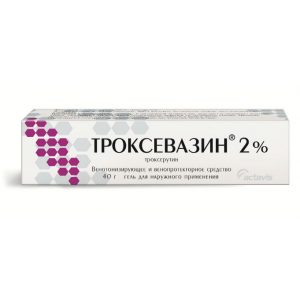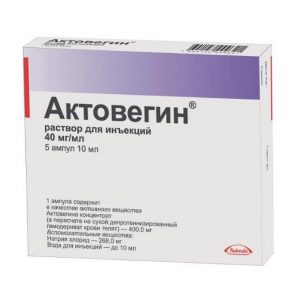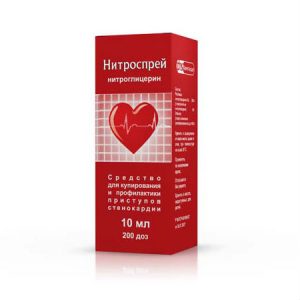Description
Pharmacological action
Combined antihypertensive drug. The composition of the drug Edarbi ® Clo includes an angiotensin II receptor antagonist (azilsartan medoxomil) and a thiazide-like diuretic (chlortalidone). The simultaneous use of two active substances leads to a more pronounced decrease in blood pressure compared with taking each of them in monotherapy. When taking the drug 1 time / day, an effective decrease in blood pressure is achieved within 24 hours.
Azilsartan medoxomil is a specific antagonist of angiotensin II receptors type 1 (AT1). Angiotensin II is formed from angiotensin I in a reaction catalyzed by an angiotensin converting enzyme (ACE, kininase II). Angiotensin II is the main vasoconstrictor factor of RAAS, its action includes vasoconstriction, stimulation of the synthesis and secretion of aldosterone, increased heart rate and sodium reabsorption by the kidneys.
Azilsartan Medoxomil is a prodrug for oral administration. It quickly turns into an active molecule of azilsartan, which selectively prevents the development of the effects of angiotensin II by blocking its binding to the AT1 receptor in various tissues, for example, in the smooth muscles of blood vessels and adrenal glands. Therefore, its effect is not associated with the biosynthesis of angiotensin II. The AT2 receptor is also found in many tissues, but it is not involved in the regulation of the cardiovascular system. The affinity of azilsartan for the AT1 receptor is 10,000 times higher than for the AT2 receptor.
Inhibition of RAAS activity by ACE inhibitors that inhibit the formation of angiotensin II from angiotensin I is widely used in the treatment of arterial hypertension. ACE inhibitors also inhibit the breakdown of bradykinin, which is catalyzed by ACE. Since azilsartan does not inhibit ACE (kininase II), it should not affect the activity of bradykinin. Azilsartan does not bind to other receptors or ion channels, which play an important role in the regulation of the cardiovascular system, and does not block them.
Azilsartan dose-dependently suppresses the vasoconstrictive effects of angiotensin II infusion. A single dose of azilsartan in a dose equivalent to 32 mg of azilsartan medoxomil suppressed the maximum vasoconstrictor effect of angiotensin II by about 90% at the time of the highest concentration, and by about 60% 24 hours after administration. In healthy volunteers, the concentrations of angiotensin I and angiotensin II and plasma renin activity increased, and the concentration of aldosterone decreased after a single oral dose and after repeated doses of azilsartan, medoxomil did not show a clinically significant effect on serum potassium or sodium. In general, the pharmacodynamic properties of azilsartan medoxomil are consistent with blocking AT1 receptors.
The antihypertensive effect of azilsartan medoxomil develops during the first 2 weeks of use with maximum therapeutic effect after 4 weeks. A decrease in blood pressure after oral administration of a single dose is usually achieved for several hours and persists for 24 hours.
Chlortalidone is a thiazide-like diuretic that inhibits active reabsorption of sodium ions in the renal tubules (the initial part of the distal convoluted tubule of the nephron), increasing the excretion of sodium and chlorine ions and enhancing diuresis. In addition, chlortalidone increases the excretion of potassium, magnesium and bicarbonate ions, delays calcium ions and uric acid. The antihypertensive effect of chlortalidone is associated with the excretion of fluid and sodium from the body. The diuretic effect develops 2-3 hours after ingestion of chlortalidone inside and persists for 2-3 days.
The antihypertensive effect of chlortalidone develops gradually with the achievement of the maximum therapeutic effect 2-4 weeks after the start of therapy.
In clinical trials, the combination of azilsartan medoxomil / chlortalidone was more effective than the combination of azilsartan medoxomil with hydrochlorothiazide or the combination of olmesartan medoxomil / hydrochlorothiazide, despite the fact that a higher proportion of participants in the comparison group required a dose increase due to insufficient control.
In a double-blind study with a planned dose increase of 12 weeks, the combination of azilsartan medoxomil / chlortalidone at a dose of 40 mg / 25 mg was statistically significantly superior to the combination of olmesartan medoxomil / hydrochlorothiazide 40 mg / 25 mg in reducing systolic blood pressure in moderate to severe arterial hypertension. Similar results were obtained in all subgroups of patients, regardless of age, gender or race. The combination of azilsartan medoxomil / chlortalidone reduced blood pressure more effectively than the combination of olmesartan medoxomil / hydrochlorothiazide every hour of the 24-hour interval between doses of drugs, according to the ABPM (daily monitoring of blood pressure).
Indications
essential hypertension (for patients who are shown combination therapy).
Contraindications
hypersensitivity to active substances and other components of the drug
refractory hypokalemia
anuria
simultaneous administration of aliskiren and aliskiren-containing drugs in patients with diabetes mellitus or moderate or severe sfd less than 60 ml form of diabetes
severe liver dysfunction (more than 9 points on the Child-Pugh scale), because no experience with the use of
severe renal failure (CC less than 30 ml / min), because there is no experience with
under the age of 18 years (efficacy and safety have not been established)
pregnancy and the period of breastfeeding.
Caution:
severe chronic heart failure (FC IV according to NYHA classification)
impaired renal function (CC more than 30 ml / min)
impaired liver function mild to moderate (5-9 points on the Child-Pugh scale)
bilateral renal artery stenosis and stenosis arteries of the only functioning kidney
ischemic cardiomyopathy
ischemic cerebrovascular disease
condition after kidney transplantation
conditions accompanied by a decrease in bcc (including vomiting, diarrhea, the use of diuretics in high doses), as well patients with a diet restriction salt
primary hyperaldosteronism
hyperuricemia, gout
hypokalemia
bronchial asthma
systemic lupus erythematosus
aortic and mitral valve stenosis
hypertrophic obstructive cardiomyopathy (GOKMP)
over 75 years old.
Composition
1 tab. contains: Active substances: azilsartan medoxomil potassium – 42.68 mg, which corresponds to the content of azilsartan medoxomil 40 mg, chlortalidone – 12.5 mg.
Excipients: mannitol – 211.23 mg, microcrystalline cellulose – 54 mg, fumaric acid – 2 mg, sodium hydroxide – 0.69 mg, hyprolose – 10.8 mg, crospovidone – 22.5 mg, magnesium stearate – 3.6 mg.
The composition of the film membrane: hypromellose 2910 – 7.8 mg, talc – 1.2 mg, titanium dioxide – 0.99 mg, dye iron oxide red – 0.01 mg, macrogol 8000 – 0.18 mg, gray ink F1 peeled for marking – trace amounts.
Dosage and administration
Edarbi ® Cloe is taken orally 1 time / day, regardless of the meal time.
The recommended starting dose of Edarbi ® Cloe is 40 mg of azilsartan medoxomil + 12.5 mg of chlortalidone 1 time / day.
If you need to further reduce blood pressure, the dose of Edarbi ® Klo can be increased to a maximum of 40 mg of azilsartan medoxomil + 25 mg of chlortalidone 1 time / day.
Edarbi ® Clos should be taken daily, without interruption. If treatment is discontinued, the patient should inform the doctor.
If you miss the next dose, the patient should take the next dose at the usual time. Do not take a double dose of Edarbi ® Clough.
Withdrawal syndrome with a sudden cessation of azilsartan medoxomil after prolonged therapy (for 6 months) was not observed. Nevertheless, the abolition of the drug Edarbi ® Clos after prolonged treatment should be carried out, if possible, gradually.
In elderly patients (65 years and older), initial dose adjustment is not required.
There is no clinical experience with the use of the drug Edarbi ® Clo in patients with severe hypertension with impaired renal function (CC less than 30 ml / min), therefore, it is not recommended to use the drug in this category of patients. In patients with impaired renal function of mild to moderate severity (CC more than 30 ml / min), dosage adjustment is not required.
The use of the drug in patients with severe liver dysfunction is not recommended, because there is no clinical experience with the use (see section Contraindications). Due to limited application experience, Edarbi ® Clough should be used with caution in patients with mild to moderate hepatic impairment (less than 9 points on the Child-Pugh scale), since even small disturbances in the water-electrolyte balance when taking diuretics can provoke hepatic coma. It is recommended to actively monitor the condition of such patients.
In patients with reduced BCC, before starting the use of the drug Edarbi ® Clo, it is necessary to replenish the loss of fluid and electrolytes.
In patients with arterial hypertension with severe chronic heart failure (FC IV according to NYHA classification), Edarbi ® Clo should be used with caution due to the lack of clinical experience.
In patients of the Negroid race, dose adjustment is not required because the antihypertensive effect of the drug Edarbi ® Clo in this category of patients is similar to its effect in patients of other races.
Side effects
Determination of the frequency of adverse reactions according to WHO recommendations: very often (> 1/10) often (> 1/100, <1/10) infrequently (> 1/1000, <1/100 rarely (> 1 / 10,000, <1/1000) is very rare (<1/10 000), including individual messages of unspecified frequency (the frequency cannot be calculated from the available data). itching Allergic reactions Rarely Angioedema From the musculoskeletal system Infrequently Muscle spasms part of metabolism Often Hyperuricemia Infrequently hypokalemia Increasing potassium Hyponatremia exacerbation of gout Laboratory parameters Very often Increased creatinine concentration Often Increased urea concentration Infrequently Increased glucose concentration Common reactions Often Increased fatigue Peripheral edema zilsartana medoxomil (monotherapy) frequency of adverse reactions the nervous system Often Dizziness Uncommon Headache Cardio-vascular system Uncommon Severe reduction in blood pressure From the itching Allergic reactions Rarely Angioedema From the musculoskeletal system Infrequently Muscle spasms Laboratory parameters Often Increased CPK Infrequently Increased creatinine concentration Hyperuricemia General reaction Infrequently Fatigue Peripheral edema chlorthalidone (monotherapy) Frequency Adverse reactions From the nervous system Rarely Headache From the cardiovascular system Often Severe reduction in blood pressure Rarely Arrhythmia Digestive system Often Loss of appetite Gastrointestinal disorders Rarely Constipation Abdominal pain Intrahepatic cholestasis or jaundice Very rarely Pancreatitis Skin and tissue Rarely Photosensitivity Cutaneous vasculitis Allergic reactions Often Urticaria The respiratory system Rarely Allergic pulmonary edema Urinary system rare allergic interstitial nephritis From the system hematopoiesis Rarely Thrombocytopenia Leukopenia Agranulocytosis Eosinophilia From the metabolism Very often Hyperlipidemia Hypokalemia Often Hypomagnesemia Rarely Hypercalcemia Glucosuria Decompensation I existing diabetes Very rarely gipohloremichesky alkalosis Other Often potency Reduced Description of individual adverse reactions In an application azilsartana medoxomil with chlorthalidone frequency of adverse reactions – a marked decrease in blood pressure and an increase in creatinine concentration – increases in frequency of occurrence: from infrequently to often. This is due to a more effective reduction in blood pressure compared with monoxysilane azilsartan medoxomil. Most of these effects were short-term or non-progressive while patients continued therapy. After discontinuation of the drug, most cases of an increase in creatinine concentration that did not pass during treatment were reversible. An increase in the concentration of uric acid when using the drug Edarbi ®Klo is due to chlortalidone included in its composition and depends on the dose of the diuretic. Reports of gout development were infrequent even with prolonged therapy. With the simultaneous use of azilsartan medoxomil with chlortalidone, the incidence of an adverse reaction, such as hypokalemia, is reduced. If any of the above side effects get worse or any other side effects appear, you should inform your doctor. Storage conditions The drug should be stored in its original packaging, out of the reach of children, in a dry, dark place at temperatures above 25 ° C. Expiration 3 years. dosage form tablets




